[English] 日本語
 Yorodumi
Yorodumi- PDB-4zyc: Discovery of dihydroisoquinolinone derivatives as novel inhibitor... -
+ Open data
Open data
- Basic information
Basic information
| Entry | Database: PDB / ID: 4zyc | ||||||
|---|---|---|---|---|---|---|---|
| Title | Discovery of dihydroisoquinolinone derivatives as novel inhibitors of the p53-MDM2 interaction with a distinct binding mode: Hdm2 (MDM2) complexed with cpd5 | ||||||
 Components Components | E3 ubiquitin-protein ligase Mdm2 | ||||||
 Keywords Keywords | LIGASE / PPI WITH P53 / INHIBITOR COMPLEX | ||||||
| Function / homology |  Function and homology information Function and homology informationcellular response to vitamin B1 / response to formaldehyde / response to water-immersion restraint stress / response to ether / traversing start control point of mitotic cell cycle / atrial septum development / regulation of protein catabolic process at postsynapse, modulating synaptic transmission / fibroblast activation / Trafficking of AMPA receptors / receptor serine/threonine kinase binding ...cellular response to vitamin B1 / response to formaldehyde / response to water-immersion restraint stress / response to ether / traversing start control point of mitotic cell cycle / atrial septum development / regulation of protein catabolic process at postsynapse, modulating synaptic transmission / fibroblast activation / Trafficking of AMPA receptors / receptor serine/threonine kinase binding / peroxisome proliferator activated receptor binding / negative regulation of intrinsic apoptotic signaling pathway by p53 class mediator / positive regulation of vascular associated smooth muscle cell migration / negative regulation of protein processing / SUMO transferase activity / response to steroid hormone / response to iron ion / AKT phosphorylates targets in the cytosol / NEDD8 ligase activity / atrioventricular valve morphogenesis / cellular response to peptide hormone stimulus / endocardial cushion morphogenesis / ventricular septum development / positive regulation of muscle cell differentiation / cardiac septum morphogenesis / regulation of postsynaptic neurotransmitter receptor internalization / blood vessel development / SUMOylation of ubiquitinylation proteins / cellular response to alkaloid / ligase activity / Constitutive Signaling by AKT1 E17K in Cancer / regulation of protein catabolic process / negative regulation of signal transduction by p53 class mediator / negative regulation of DNA damage response, signal transduction by p53 class mediator / SUMOylation of transcription factors / response to magnesium ion / cellular response to UV-C / protein sumoylation / cellular response to actinomycin D / cellular response to estrogen stimulus / blood vessel remodeling / protein localization to nucleus / ribonucleoprotein complex binding / protein autoubiquitination / positive regulation of vascular associated smooth muscle cell proliferation / NPAS4 regulates expression of target genes / transcription repressor complex / positive regulation of mitotic cell cycle / regulation of heart rate / proteolysis involved in protein catabolic process / positive regulation of protein export from nucleus / ubiquitin binding / response to cocaine / DNA damage response, signal transduction by p53 class mediator / Stabilization of p53 / establishment of protein localization / Regulation of RUNX3 expression and activity / cellular response to gamma radiation / Oncogene Induced Senescence / RING-type E3 ubiquitin transferase / Regulation of TP53 Activity through Methylation / protein destabilization / cellular response to growth factor stimulus / response to toxic substance / centriolar satellite / cellular response to hydrogen peroxide / protein polyubiquitination / disordered domain specific binding / ubiquitin-protein transferase activity / p53 binding / endocytic vesicle membrane / ubiquitin protein ligase activity / Signaling by ALK fusions and activated point mutants / Regulation of TP53 Degradation / positive regulation of proteasomal ubiquitin-dependent protein catabolic process / negative regulation of neuron projection development / 5S rRNA binding / protein-containing complex assembly / ubiquitin-dependent protein catabolic process / Oxidative Stress Induced Senescence / cellular response to hypoxia / Regulation of TP53 Activity through Phosphorylation / amyloid fibril formation / proteasome-mediated ubiquitin-dependent protein catabolic process / regulation of cell cycle / Ub-specific processing proteases / postsynaptic density / protein ubiquitination / response to xenobiotic stimulus / protein domain specific binding / response to antibiotic / negative regulation of DNA-templated transcription / positive regulation of cell population proliferation / apoptotic process / ubiquitin protein ligase binding / positive regulation of gene expression / negative regulation of apoptotic process / nucleolus / glutamatergic synapse / enzyme binding Similarity search - Function | ||||||
| Biological species |  Homo sapiens (human) Homo sapiens (human) | ||||||
| Method |  X-RAY DIFFRACTION / X-RAY DIFFRACTION /  SYNCHROTRON / SYNCHROTRON /  MOLECULAR REPLACEMENT / MOLECULAR REPLACEMENT /  molecular replacement / Resolution: 1.95 Å molecular replacement / Resolution: 1.95 Å | ||||||
 Authors Authors | Kallen, J. | ||||||
 Citation Citation |  Journal: Bioorg.Med.Chem.Lett. / Year: 2015 Journal: Bioorg.Med.Chem.Lett. / Year: 2015Title: Discovery of dihydroisoquinolinone derivatives as novel inhibitors of the p53-MDM2 interaction with a distinct binding mode. Authors: Gessier, F. / Kallen, J. / Jacoby, E. / Chene, P. / Stachyra-Valat, T. / Ruetz, S. / Jeay, S. / Holzer, P. / Masuya, K. / Furet, P. | ||||||
| History |
|
- Structure visualization
Structure visualization
| Structure viewer | Molecule:  Molmil Molmil Jmol/JSmol Jmol/JSmol |
|---|
- Downloads & links
Downloads & links
- Download
Download
| PDBx/mmCIF format |  4zyc.cif.gz 4zyc.cif.gz | 70.7 KB | Display |  PDBx/mmCIF format PDBx/mmCIF format |
|---|---|---|---|---|
| PDB format |  pdb4zyc.ent.gz pdb4zyc.ent.gz | 52.5 KB | Display |  PDB format PDB format |
| PDBx/mmJSON format |  4zyc.json.gz 4zyc.json.gz | Tree view |  PDBx/mmJSON format PDBx/mmJSON format | |
| Others |  Other downloads Other downloads |
-Validation report
| Summary document |  4zyc_validation.pdf.gz 4zyc_validation.pdf.gz | 1.4 MB | Display |  wwPDB validaton report wwPDB validaton report |
|---|---|---|---|---|
| Full document |  4zyc_full_validation.pdf.gz 4zyc_full_validation.pdf.gz | 1.4 MB | Display | |
| Data in XML |  4zyc_validation.xml.gz 4zyc_validation.xml.gz | 13.2 KB | Display | |
| Data in CIF |  4zyc_validation.cif.gz 4zyc_validation.cif.gz | 17.7 KB | Display | |
| Arichive directory |  https://data.pdbj.org/pub/pdb/validation_reports/zy/4zyc https://data.pdbj.org/pub/pdb/validation_reports/zy/4zyc ftp://data.pdbj.org/pub/pdb/validation_reports/zy/4zyc ftp://data.pdbj.org/pub/pdb/validation_reports/zy/4zyc | HTTPS FTP |
-Related structure data
| Related structure data | 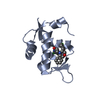 4dijS S: Starting model for refinement |
|---|---|
| Similar structure data |
- Links
Links
- Assembly
Assembly
| Deposited unit | 
| ||||||||
|---|---|---|---|---|---|---|---|---|---|
| 1 | 
| ||||||||
| 2 | 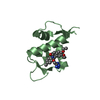
| ||||||||
| 3 | 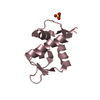
| ||||||||
| Unit cell |
|
- Components
Components
| #1: Protein | Mass: 11172.008 Da / Num. of mol.: 3 Fragment: N-TERMINAL DOMAIN, P53-BINDING DOMAIN, UNP residues 17-111 Mutation: L33E Source method: isolated from a genetically manipulated source Source: (gene. exp.)  Homo sapiens (human) / Gene: MDM2 / Production host: Homo sapiens (human) / Gene: MDM2 / Production host:  References: UniProt: Q00987, Ligases; Forming carbon-nitrogen bonds; Acid-amino-acid ligases (peptide synthases) #2: Chemical | #3: Chemical | ChemComp-SO4 / | #4: Water | ChemComp-HOH / | |
|---|
-Experimental details
-Experiment
| Experiment | Method:  X-RAY DIFFRACTION / Number of used crystals: 1 X-RAY DIFFRACTION / Number of used crystals: 1 |
|---|
- Sample preparation
Sample preparation
| Crystal | Density Matthews: 0 Å3/Da / Density % sol: 0 % |
|---|---|
| Crystal grow | Temperature: 298 K / Method: vapor diffusion, hanging drop / pH: 8 Details: reservoir: 2.2M ammonium sulphate, 0.2M KNa tartrate, protein: 10mg/ml Hdm2 in 50mM TRIS pH 8.0, 200mM NaCl, 1mM TCEP, 10% glycerol, drop: 0.2ul reservoir + 0.2ul protein PH range: 8 |
-Data collection
| Diffraction | Mean temperature: 100 K |
|---|---|
| Diffraction source | Source:  SYNCHROTRON / Site: SYNCHROTRON / Site:  SLS SLS  / Beamline: X10SA / Wavelength: 0.9794 Å / Beamline: X10SA / Wavelength: 0.9794 Å |
| Detector | Type: MARRESEARCH / Detector: CCD / Date: Nov 7, 2008 |
| Radiation | Monochromator: SI 111 CHANNEL / Protocol: SINGLE WAVELENGTH / Monochromatic (M) / Laue (L): M / Scattering type: x-ray |
| Radiation wavelength | Wavelength: 0.9794 Å / Relative weight: 1 |
| Reflection | Resolution: 1.95→20 Å / Num. obs: 21169 / % possible obs: 99.8 % / Redundancy: 5.3 % / Rmerge(I) obs: 0.056 / Χ2: 0.979 / Net I/av σ(I): 31.07 / Net I/σ(I): 31.07 / Num. measured all: 112750 |
| Reflection shell | Resolution: 1.95→2.02 Å / Redundancy: 5.3 % / Rmerge(I) obs: 0.25 / Mean I/σ(I) obs: 4.21 / Num. unique all: 2147 / Χ2: 1.789 / Rejects: 0 / % possible all: 100 |
-Phasing
| Phasing | Method:  molecular replacement molecular replacement |
|---|
- Processing
Processing
| Software |
| |||||||||||||||||||||||||||||||||||||||||||||
|---|---|---|---|---|---|---|---|---|---|---|---|---|---|---|---|---|---|---|---|---|---|---|---|---|---|---|---|---|---|---|---|---|---|---|---|---|---|---|---|---|---|---|---|---|---|---|
| Refinement | Method to determine structure:  MOLECULAR REPLACEMENT MOLECULAR REPLACEMENTStarting model: 4DIJ Resolution: 1.95→20 Å / Cor.coef. Fo:Fc: 0.937 / Cor.coef. Fo:Fc free: 0.921 / WRfactor Rfree: 0.2718 / WRfactor Rwork: 0.2326 / FOM work R set: 0.8309 / SU B: 3.718 / SU ML: 0.11 / SU R Cruickshank DPI: 0.2044 / SU Rfree: 0.1754 / Cross valid method: THROUGHOUT / σ(F): 0 / ESU R: 0.204 / ESU R Free: 0.175 / Stereochemistry target values: MAXIMUM LIKELIHOOD Details: HYDROGENS HAVE BEEN ADDED IN THE RIDING POSITIONS U VALUES : REFINED INDIVIDUALLY
| |||||||||||||||||||||||||||||||||||||||||||||
| Solvent computation | Ion probe radii: 0.8 Å / Shrinkage radii: 0.8 Å / VDW probe radii: 1.2 Å / Solvent model: MASK | |||||||||||||||||||||||||||||||||||||||||||||
| Displacement parameters | Biso max: 73.82 Å2 / Biso mean: 30.121 Å2 / Biso min: 16.48 Å2
| |||||||||||||||||||||||||||||||||||||||||||||
| Refinement step | Cycle: final / Resolution: 1.95→20 Å
| |||||||||||||||||||||||||||||||||||||||||||||
| Refine LS restraints |
| |||||||||||||||||||||||||||||||||||||||||||||
| LS refinement shell | Resolution: 1.95→2 Å / Total num. of bins used: 20
|
 Movie
Movie Controller
Controller


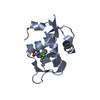

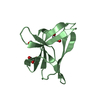
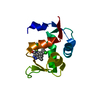
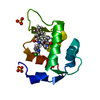

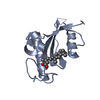




 PDBj
PDBj














